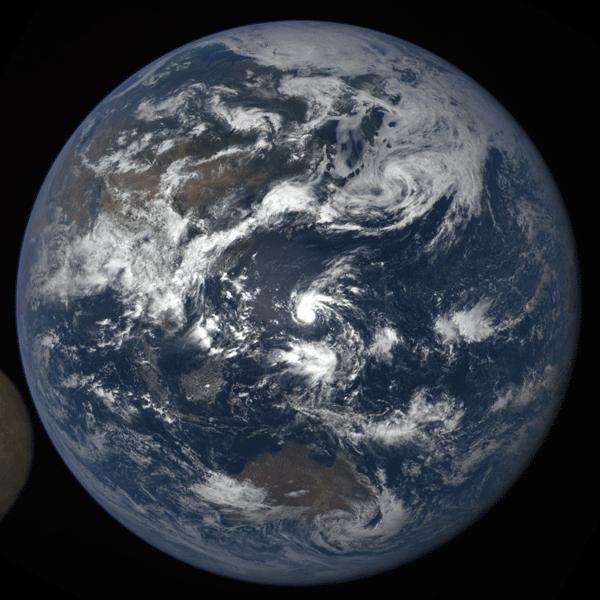NASA camera catches moon 'photobombing' Earth

On July 5, 2016, the moon passed between NOAA's DSCOVR satellite and Earth. NASA's EPIC camera aboard DSCOVR snapped these images over a period of about four hours. In this set, the far side of the moon, which is never seen from Earth, passes by. In the backdrop, Earth rotates, starting with the Australia and Pacific and gradually revealing Asia and Africa. Credit: NASA/NOAA
For only the second time in a year, a NASA camera aboard the Deep Space Climate Observatory (DSCOVR) satellite captured a view of the moon as it moved in front of the sunlit side of Earth.
“For the second time in the life of DSCOVR, the moon moved between the spacecraft and Earth,” said Adam Szabo, DSCOVR project scientist at NASA's Goddard Space Flight Center in Greenbelt, Maryland. “The project recorded this event on July 5 with the same cadence and spatial resolution as the first 'lunar photobomb' of last year.”
The images were captured by NASA's Earth Polychromatic Imaging Camera (EPIC), a four-megapixel CCD camera and telescope on the DSCOVR satellite orbiting 1 million miles from Earth. From its position between the sun and Earth, DSCOVR conducts its primary mission of real-time solar wind monitoring for the National Oceanic and Atmospheric Administration (NOAA).
EPIC maintains a constant view of the fully illuminated Earth as it rotates, providing scientific observations of ozone, vegetation, cloud height and aerosols in the atmosphere. The EPIC camera is providing a series of Earth images allowing study of daily variations over the entire globe.
These images were taken between July 4 at 11:50 p.m. EDT and July 5 at 3:18 a.m. EDT (0350 UTC and 0718 UTC on July 5), showing the moon moving over the Indian and Pacific oceans. The North Pole is at the top of the images.
DSCOVR is orbiting around the sun-Earth first Lagrange point (where the gravitational pull of Earth is equal and opposite of that of the sun) in a complex, non-recurring orbit that changes from an ellipse to a circle and back (called a Lissajous orbit) taking the spacecraft between 4 and 12 degrees from the sun-Earth line. This orbit intersects the lunar orbit about four times a year. However, depending on the relative orbital phases of the moon and DSCOVR, the moon appears between the spacecraft and Earth once or twice a year.
The last time EPIC captured this event was between 3:50 p.m. and 8:45 p.m. EDT on July 16, 2015.
EPIC's “natural color” images of Earth are generated by combining three separate monochrome exposures taken by the camera in quick succession. EPIC takes a series of 10 images using different narrowband spectral filters — from ultraviolet to near infrared — to produce a variety of science products. The red, green and blue channel images are used in these color images.
Combining three images taken about 30 seconds apart as the moon moves produces a slight but noticeable camera artifact on the right side of the moon. Because the moon has moved in relation to Earth between the time the first (red) and last (green) exposures were made, a thin green offset appears on the right side of the moon when the three exposures are combined. This natural lunar movement also produces a slight red and blue offset on the left side of the moon in these unaltered images.
DSCOVR is a partnership between NASA, NOAA and the U.S. Air Force with the primary objective of maintaining the nation's real-time solar wind monitoring capabilities, which are critical to the accuracy and lead time of space weather alerts and forecasts from NOAA.
Media Contact
All latest news from the category: Physics and Astronomy
This area deals with the fundamental laws and building blocks of nature and how they interact, the properties and the behavior of matter, and research into space and time and their structures.
innovations-report provides in-depth reports and articles on subjects such as astrophysics, laser technologies, nuclear, quantum, particle and solid-state physics, nanotechnologies, planetary research and findings (Mars, Venus) and developments related to the Hubble Telescope.
Newest articles

First-of-its-kind study uses remote sensing to monitor plastic debris in rivers and lakes
Remote sensing creates a cost-effective solution to monitoring plastic pollution. A first-of-its-kind study from researchers at the University of Minnesota Twin Cities shows how remote sensing can help monitor and…

Laser-based artificial neuron mimics nerve cell functions at lightning speed
With a processing speed a billion times faster than nature, chip-based laser neuron could help advance AI tasks such as pattern recognition and sequence prediction. Researchers have developed a laser-based…

Optimising the processing of plastic waste
Just one look in the yellow bin reveals a colourful jumble of different types of plastic. However, the purer and more uniform plastic waste is, the easier it is to…


